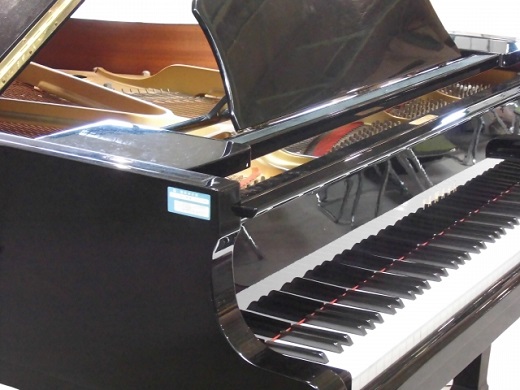
Chopin’s “Waltz No. 7 in C-sharp minor, Op. 64-2”—a somewhat melancholic yet elegant piece. It evokes the kind of atmosphere you might find in a classy bar. Many people probably think, “It’d be so cool to play this piece!”
However, when glancing at the sheet music, some might get the impression that it looks difficult. But don’t worry! Once you understand a few key tips and practice with them in mind, you’ll find it’s not as daunting as it first seems. If you’re debating whether to give it a try, this article is for you!
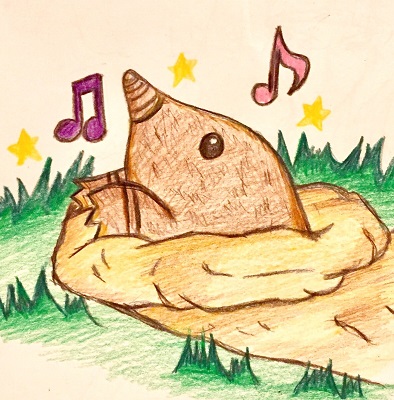
Hello, I’m Mole, a pianist. “Wait, a mole?” you might ask. Yes, that’s right—a mole. I love spending time underground in fields, but I love playing the piano just as much.
There are countless creatures living in this world, and whether you’re a mole or a human or something else entirely, I firmly believe that a love for music transcends all species. With this belief, I happily teach piano every day.
Contents
Understanding the Key Makes It Manageable!

As for the difficulty level, if you’re practicing pieces around the level of Czerny’s 30 Études, you should be able to give this piece a try. To summarize, it’s not extremely difficult.
That said, being able to play Czerny’s 30 Études fluently doesn’t necessarily guarantee you’ll find this piece easy. The reason is that this piece can be challenging to practice if you don’t have a solid understanding of the key.
So, I’d say that more than mastering Czerny’s 30 Études, it’s crucial to ensure you’re comfortable with scale exercises, like those in Hanon’s Exercises for the Virtuoso Pianist.
While I mentioned scale exercises, this is just an example. Any exercises that help you study keys, such as arpeggio practices, will work just as well. The most important thing is to have a solid understanding of the key when tackling this piece.
Now, while I’m saying all this as advice, I must confess that I myself once tried to tackle this piece without understanding the key. Unsurprisingly, it was a tough road to mastery. If I had at least taken the time to understand the keys of C-sharp minor and D-flat major beforehand, I could have avoided such inefficient practice.
In short, if you combine the skills from Czerny’s 30 Études with a solid understanding of the key, you’ll be well-prepared to master this piece. Let’s do our best!
The Structure Is Full of Repetition!

This piece has quite a few repeated sections, making its structure relatively easy to understand. Pay attention to how the piece transitions between different sections.
First, please listen to this video.
To explain this piece, I’ve divided it into several sections as shown below. I will go over each section one by one.
Section A (Beginning–0:43)
Section B (0:44–1:07)
Section C (1:07–1:48)
Section B (1:48–2:11)
Section A (2:11–2:53)
Section B (2:53–End)
The times in parentheses correspond to the video. Watching the video carefully and understanding the structure of the piece will make practicing much easier.
As you can see in the video, once you master the first three sections—Section A, B, and C—the rest of the piece is just a repetition of Section A and B.
This means that once you’ve learned about half of the score, you’ll essentially be able to play the entire piece. Thinking of it this way makes it a little less daunting, doesn’t it?
Now, let’s dive into the details of each section!
How to Play Mole-Style!
☆How to Play Section A – Pay Attention to Accidentals
Right from the start, I must say that I think Section A is the most challenging part of this piece.For those of you thinking, “Oh no, seriously?” don’t worry. If you can clear the hardest part first, the rest will feel much easier.
 ※ The meaning of “Tempo giusto” is “at an exact speed.”
※ The meaning of “Tempo giusto” is “at an exact speed.”You might be wondering, “What is this weird X-shaped symbol?” That’s a double sharp, an accidental.
You know that a sharp (♯) raises a note by a half step, right? A double sharp means raising it by another half step.
In other words, this “F double sharp” is actually the note G on the keyboard.
You might feel tempted to say, “Then why not just write it as G natural?” But let’s resist the urge for now. I’m resisting it, too.
Next, there’s that symbol that looks like a natural and sharp combined—it means “cancel the double sharp and then raise the note by a half step.”
So, this note would simply be F sharp. It’s super confusing, isn’t it? But let’s hang in there.
By the way, as I mentioned earlier, I didn’t fully understand the key signature when I first tried this piece, and I ended up giving up after just practicing the right hand at the start.
This piece starts in C-sharp minor, a key that mixes black and white keys, making it really challenging to play. On top of that, there are all these accidentals, so tackling this piece without understanding the key signature is, in my opinion, nearly impossible.
To avoid the sad situation of giving up, understanding the key signature is an essential preparation step for practice. Take the time to understand the key signature, and practice the right hand slowly and patiently.
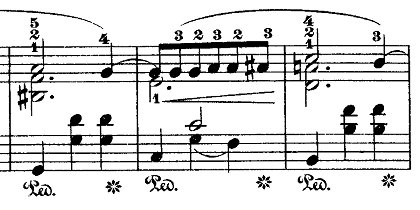
In parts like this, it’s important to bring out the phrases that form the main melody.
To do that, you first need to identify where the main melody is. (0:12–)
But this score makes it clear. Some notes have stems pointing upward, while others have stems pointing downward. The notes with upward stems are the main melody.
To emphasize the main melody in this part, it’s better to focus on playing the notes with downward stems more quietly, rather than simply increasing the volume of the main melody.
That’s because, while the main melody is indeed important, if you focus too much on emphasizing it, the overall sound may become too loud.
Listen carefully and aim to grasp the overall balance of the sound.
For the left hand, give priority to the first beat of each measure. Keeping the second and third beats quieter will result in a cleaner resonance.
Once you’ve got the basics of playing with both hands, you can add the pedal. However, be careful with the pedal in Section A.
If you press the pedal incorrectly, it will emphasize dissonance and create an unpleasant sound.
I recommend following the score as faithfully as possible when using the pedal.
☆How to Play Section B – Emphasize the Waltz Rhythm
Now, Section B has a slightly lighter atmosphere compared to Section A. You can also sense the characteristic mood of a waltz here. (0:44~) ※ “Piu mosso” means “faster than before”
※ “Piu mosso” means “faster than before”Looking at the sheet music for Section B, you might notice that similar phrases appear in each measure. These phrases gradually descend lower in pitch with each measure.
Play this part with attention to the slurs (meaning: play smoothly) so that the phrases don’t get interrupted midway. To achieve this, it’s important to focus on finger movement.
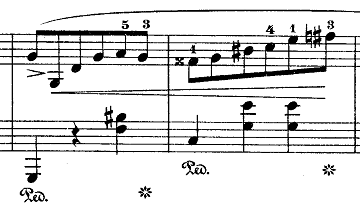
In this section, the descending notes rise back up to their original pitch, so adding a touch of dynamics here might make it more interesting. (0:49~)
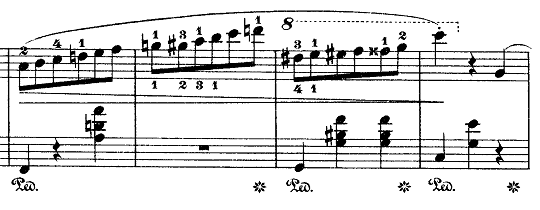
This part is quite challenging for me. If I’m not careful, my fingers tend to get tangled. Since the finger movement here is particularly tricky, I recommend practicing this section carefully with one hand at a time. (0:53~)
☆How to Play Section C – Play Elegantly and Freely
The melancholic atmosphere up to this point shifts dramatically in Section C, which brings a brighter mood. The key also changes from C-sharp minor to D-flat major in this section. ※ “Piu lento” means “even slower”
※ “Piu lento” means “even slower”In such passages, pay attention to the slurs and ties (meaning: connect the notes) and think carefully about where in the phrase to build up the dynamics before you start playing.
What’s crucial in Section C is not losing track of the waltz rhythm. This is because Section C contains many slightly irregular ties that stretch across measures.
If you lose the sense of the 3/4 waltz rhythm here, you might suddenly find yourself unsure of what you’re playing, which can result in the entire piece lacking contrast.
When I play Section C, I’m often tempted to add plenty of dynamics. However, if you go overboard and add too many dynamics here and there, the melodic flow might break, leading to an overall instability in tempo.
Well, the way you play Section C and how it feels to the listener may vary from person to person. This is where individuality shines the most, so there’s no definitive right or wrong way to add dynamics. That said, if the flow of the piece stalls, it can create a sense of discomfort. Make sure to add dynamics in moderation.

As for these eighth-note runs, I don’t think you need to overthink them. Even if the tempo slows down a bit here, it’s not a major problem—at least, that’s my personal opinion. Others might disagree. This is another spot where the performer’s individuality truly stands out. (1:31~)
☆Playing the Remaining Sections: Repetition of Sections A and B
The explanation up to Section C is complete. Great work!The remaining few pages are repetitions of Sections A and B. The sequence goes: Section B (1:48~) → Section A (2:11~) → Section B (2:53~). At this point, you’ve almost mastered it!
However, there’s one thing I want to address about the very last part of the piece.
The ending of the piece, specifically the final part of Section B, requires particular attention. The right hand ascends to higher notes in this section.
If you play this part the same way as Section B from earlier in the piece, the ending can feel dull or overly plain, failing to evoke the sense of finality the conclusion should have.
This is a part where I often struggle. When I perform this piece for someone, they sometimes say, “Oh, did it just end?” after the piece finishes.
Well, the ending of this “Waltz No. 7” is inherently structured this way, so to some extent, it can’t be helped. However, I still find it unsatisfying.
How can we make the ending sound more conclusive? I’m still experimenting, but for now, I try to emphasize a slightly exaggerated ritardando (meaning: gradually slowing down) to bring the piece to a quiet close.
But this is not the only solution, so I encourage you to experiment and discover an interpretation that feels satisfying to you!
Key Takeaways: Tips for Playing the Entire Piece

How was the explanation so far? Below, I’ve summarized the key tips for playing Chopin’s “Waltz No. 7, Op. 64-2”:
1. Fully understand the keys (especially C-sharp minor and D-flat major) in advance, particularly for Section A and Section C.
2. Pay close attention to accidentals during the sight-reading stage and practice each hand carefully, especially for Section A and Section B.
3. Follow the pedal markings in the sheet music faithfully, ensuring the sound does not become muddled, particularly in Section A.
4. During the middle section, don’t be confused by long ties or slurs; maintain the waltz rhythm, especially in Section C.
With these four tips in mind, practice diligently and persistently!
As I briefly mentioned earlier, I once gave up on this piece. Looking back, it was because I practiced aimlessly without focusing on these key points.
However, I believe that if you prepare thoroughly with proper sight-reading and understanding of the keys and practice with these tips in mind, you can easily avoid such setbacks. Hard work never betrays effort!
So, keep practicing! I’ll be cheering you on from the depths of my burrow.
- IMSLP (Sheet Music Link)
This article was created using this sheet music, published by Schirmer in 1894 and in the public domain. All three pieces of “Waltz Op. 64” are included, with Op. 64-2 starting on page 5.
- Ranking Chopin’s Waltzes by Difficulty: A Piano Teacher’s Perspective 2017/3/17
- Perfect for a Piano Recital! Chopin's “Minute Waltz”: Difficulty and 3 Tips for Playing It 2017/5/25
- How to Master Chopin’s “Grande Valse Brillante”: Difficulty Level and Essential Waltz Techniques 2017/6/2
- Play with Fingerings That Suit You! Chopin’s “Grande Valse Brillante” Difficulty and Tips for Playing 2017/6/29
- How to Master Chopin's “Minute Waltz”: 8 Essential Tips and Difficulty Insights from a Mole 2017/7/6
- Master Chopin's “Waltz No. 7, Op. 64-2”: Tips, Tricks, and Difficulty Level Explained 2017/7/14 ←Currently Viewing Article
- Charming & Lyrical! Tips and Difficulty Level of Chopin's Waltz No. 14 in E Minor, Posthumous 2017/8/6
- Romantic Love! Chopin’s Waltz No. 9 Op. 69-1 Tips and Difficulty Level (“Farewell Waltz” or “Valse de l'adieu”) 2017/11/8
- The World of Brilliant Waltzes! How to Play and the Difficulty Level of Chopin’s “Grande Valse Brillante” 2017/12/6
- Chopin's Waltz No. 10, Op. 69-2: A Beginner’s Guide to Playing, Mastering, and Understanding Its Difficulty 2017/12/16
- Chopin’s Puppy Waltz Simplified: Easy Tips, Difficulty Level, and Playing Guide for Waltz No. 6 in D-flat Major, Op. 64-1 2018/3/9
- Chopin’s Waltz No. 15 in E Major: A Hidden Gem with Playing Tips and Difficulty Level Explained 2018/3/19
- Chopin’s Waltz No. 3 (Grande Valse Brillante) in A Minor, Op. 34-2: Difficulty and Playing Tips 2018/5/19
- Is Chopin’s “Minute Waltz” Hard? Learn 7 Tips to Conquer It Today 2019/8/1



















